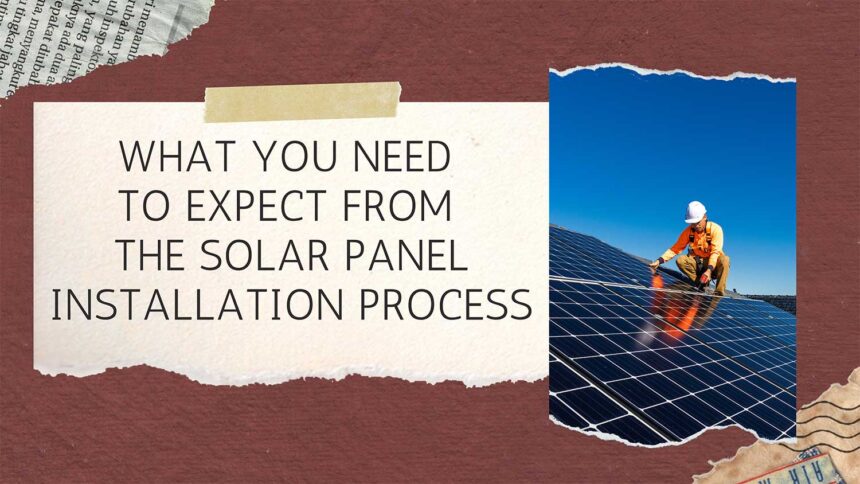If you have been thinking about solar panels, now is the right time. Solar panel installation can be overwhelming at first. Why?
You need to think about how you get started with the process. Today, we are going to give you a few insights into the full solar panel installation process. That way, you know what to expect, how to prepare for solar panel installation, and what you need to know about getting solar panels for your home.
The Solar Panel Installation Process
The solar panel installation process is relatively straightforward but can take some time to complete. Despite the long process of installation, solar panels are a great way to save energy. So once you have chosen your panel installation company, you need to follow the steps below to complete the installation.
Site Assessment and Design
The solar panel installation process begins with a site assessment and design. During this phase, a contractor will evaluate the property and determine what type of solar panel system best fits the need and budget of the customer. The contractor will then design a system.
He will also take into consideration the site location, ground area, elevation, and any potential shading. This information will then be used to determine the optimal location for the solar panels, their size, and their tilt angle. As well as what type of grounding and racking will be necessary.
Permitting
The next step of the solar panel installation process is permitting. All projects will require a permit from your local city or county. This permit process may include reviews from various departments. It will depend on the installation type and location.
Generally, you will need to provide architectural plans, site plans, and project scheduling details. Once a permit has been obtained, you will then need to contact a licensed contractor to complete the installation. The contractor will be responsible for obtaining all necessary permits.
He is also responsible for scheduling and performing the installation, also with submitting the completed paperwork to gain approval from the local government. With the right contractor, the solar panel installation process should be a breeze.
The Solar Panel Installation
The solar panel installation process is becoming increasingly popular as people are turning to renewable sources of energy. This process involves the installation of photovoltaic panels onto rooftops in order to capture the energy of the sun and convert it into usable electrical energy.
Once the design is determined, the installer will install the panels, wiring in the necessary components, and connect the panel to the electrical grid. After the installation is complete, the installer will inspect the wiring as well as the system’s performance. They will also provide ongoing maintenance to ensure that the system is working properly.
Government Inspection
Government inspection may include a review of the building or home’s existing electrical system. It will also include the installation of the solar panel system, as well as an assessment of the space available to mount and store the panels. Once the government has approved the system, the actual installation can take place.
During the installation, the installer or contractor will need to adhere to local building codes and follow all safety protocols. Then, they will install the system according to specifications. With the installation of a solar panel system, the home or business will be able to harness the natural energy of the sun.
It will also then begin to benefit from the savings that can come from using a renewable source of energy. You can enjoy the benefits of solar by completing every step. So each one is important to achieve a successful installation.
Activation
Activation is the last step in the solar panel installation process. This is where the energy produced by solar panels is turned into usable electricity. After the panels have been installed and the connections have been tested, they must be “activated” in order to receive the necessary permissions and approvals from the local utility company.
During this process, your panels will be configured so that they can provide power to your home and be connected to the electrical grid. An electrician will inspect the entire system. They will also issue the necessary certification for the property.
As well as program your system for maximum efficiency. After the installation is complete, your solar panel systems will be ready to power up your home with clean, sustainable energy!
Factors That Impact Solar Panel Installation
The solar panel installation process can be a long and arduous one. From site surveys and measurements to system design, permits, installation, and energy production, there is a multitude of complex steps. Factors that can cause disruption to the process include the following below.
Orientation and Positioning of the System
The orientation and positioning of your solar panel system will play a key role in its overall effectiveness and efficiency. Once there’s a site, experts will come to install and orient the system to ensure that it records the maximum amount of energy from the sun. If your home is in the northern hemisphere, the solar panel will have to be set to face south, and vice versa for the southern hemisphere.
Roof Type and Condition
When considering the installation process of solar panels on a roof, the type and condition of the roof are key factors to consider. For example, flat roofs are generally easier to navigate and work on.
This is opposed to pitched roofs, which require additional planning for safety. The condition of a roof is also important, as it will determine how quickly the solar panel installation process can take place.
Weather Conditions
Solar panel installation is typically done from early spring to late fall when the days are the longest, and the weather is stable and sunny. Weather can change and affect the completion of the project, delaying the process until optimal and safe conditions are present. Heavy snow or rain can affect the installation process, requiring that the installation is put on hold until the weather improves.
Learn More About Solar Panel Installation Today
The solar panel installation process is a complex but rewarding one. By understanding the steps involved, taking your time, and properly researching, you can ensure a successful installation experience. So, why not start your journey today by choosing a reliable, certified installation provider to help guide you through the process?
Did you find this article helpful? Check out the rest of our blogs!









